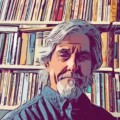News & Articles
Browse all content by date.
Sculptor Timothy Cleary, who grew up in Faribault, MN and got his B.A. at the University of Minnesota-Morris, went on to get his Masters of Fine Arts at the University of Arizona in Tucson. He currently teaches art classes at the University of Wisconsin-Superior, and occasionally sells sculptures. His sculpture titled Gown is currently on display at the Kruk Gallery, UWS. To see more, visit timothyclearysculpture.com/
EN: How did you become interested in making sculpture? Who were your influences?
Timothy Cleary: My sculptures evolved out of my paintings. I had been painting with materials that were very dimensional and tactile: cement, wax, sand, scraps of metal. Eventually I stopped fastening the work to walls and started calling it sculpture.
At that time my art heroes included Antonio Tapies and Joseph Beuys. I was very fortunate to study under mentors who taught me how to look beyond emulating the artwork I liked in order to make personal and sincere work.
EN: Where does your inspiration come from?
TC: I am inspired by the natural world, and by selflessness. This is ironic because my art processes are not environmentally friendly and my creative activities are very self-indulgent.
EN: What is your process for doing a new work?
TC: New ideas come as a surprise after a period of anxious tension. Suddenly I have a fraction of an image in my mind that suggests a possible release of that tension. Next comes a period of wrestling with materials and images until I have something in front of me that seems like the inevitable solution.
It is a kind of catharsis in slow motion. The anxiety and the relief are both evident in the finished product.
EN: Is there anything especially unique in how you create?
TC: No. My materials, methods, and strategies have been used for thousands of years.
EN: What are your primary themes?
TC: The individual striving against social convention. Vulnerability is a kind of strength. Modern social problems are actually ancient ones.
EN: Who are your favorite artists?
TC: Jean-Baptiste-Siméon Chardin, Juan Sánchez-Cotán, Hayao Miyazaki, Edward Burtynsky, Kristamas Klousch. However, I am more inspired by music than visual art. I owe a lot to Mark Hollis, David Sylvian, Kate Bush, and Ali Akbar Khan.
EN: When did you realize you were going to be serious about art?
TC: As a child I knew. Later, I tried to avoid it because of the starving artist stigma. One drawing class in college was all it took to change that.
EN: How did that come about?
TC: At the time, the creative act was more like an addiction than a pleasant vocational discovery. I am very lucky to have a supportive spouse.
EN: What are you working on now that has you jazzed?
TC: I am working on a public commission that poses a variety of creative challenges. It is a sculpture of Duluth native David Wheat, who was a prisoner in North Vietnam for over seven years. My work is usually very self-centered, with audience only playing a peripheral role. In this instance my personal impulses need to work in concert with the intent of the commission.
EN: What is the story behind you sculpture Gown at the Kruk right now? I find it interesting that the expression on this character varies from tragic to innocent based on the angle you observe it. Is this intentional?
TC: I never know the entire story behind my work. I am grateful to hear your response to his expression. It was intentional. The figure is that of a child, but one who is old enough for independent thought and action. His external circumstances are not good, evident primarily through the square holes in his torso. However, he is striding forward, toting the lamprey eels as if he’s harvested them himself for his own purposes. He has turned the tables on the would-be parasites by a power of will, though not without serious damage to himself. The holes through his chest help him carry his burden.
While working on this sculpture I was thinking of a lot of things, including children who are refugees, victims of abuse, or who are otherwise exposed to horrors of this world. My hope is that they can somehow overcome these experiences. The metaphor is not exclusive to children. It can apply to anyone. The conflict may just as easily be internally generated. The youthfulness and nudity are mechanisms to emphasize vulnerability. The title emphasizes a ritual.
EN: How was the sculpture Rite conceived? Is there a story behind the piece?
TC: The easiest description is that this is a feminist piece. The protagonist is immune to the arrows that have pierced her. She is nude, except for the absurd headdress adornment that may have been put on her by someone else. There is no suggested sexuality to the figure except that which viewers may be applying themselves. The ornate motif of the arrow fletching suggests they have the same source as the headdress. The protagonist is gazing through a veil with a dreamy indifference. It is an ineffective barrier. She is not ignorant. Perhaps the antagonist put it there to protect himself or herself from identifying with her.
I am the father of a little girl and I am sorry to acknowledge the social challenges she is already facing. This sculpture also has ancient references as well as a patina that makes it look like it was dug up from some lost civilization. The ideas embedded in the sculpture have been around for a long time. When I describe these works, I have conflicting feelings. My descriptions are accurate, but they are narratives packaged for easy consumption, and lift some of the responsibility of self-analysis from the viewer. Another part of me simply wishes to say, “These are portraits of us.”
| Tweet |


